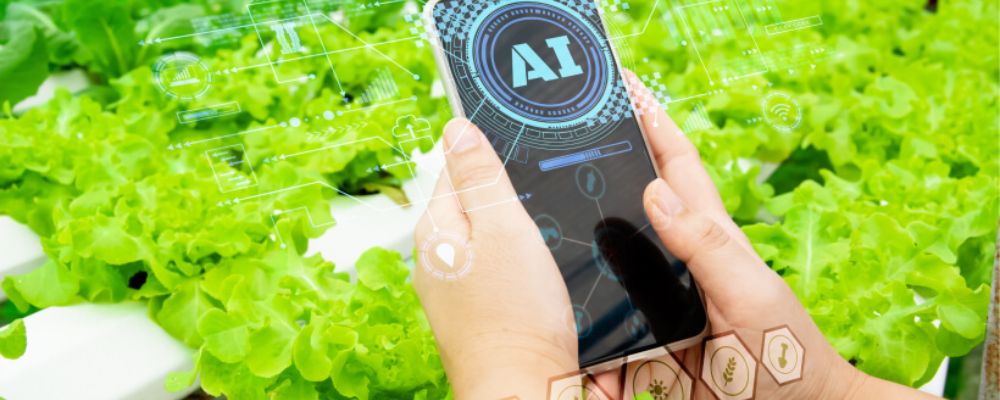
The world’s population is growing at an unprecedented rate, putting pressure on agricultural systems to produce more food with fewer resources. Traditional farming methods are no longer sufficient to meet the demands of this new era. This is where artificial intelligence (AI) steps in, revolutionizing the way we approach agriculture. By integrating AI technologies into farming practices, farmers can now increase crop yields, reduce waste, and ensure sustainability.
AI in agriculture has led to the rise of precision farming, automated systems, and data-driven decision-making that are transforming how we grow food. In this blog, we’ll explore how AI is improving crop yields, making farming smarter, more efficient, and sustainable.
The Role of AI in Precision Farming
What is Precision Farming?
Precision farming refers to the use of advanced technologies, such as AI, to monitor and manage the health of crops in real-time. By collecting data from various sources such as sensors, drones, and satellites, AI tools can analyze and predict the optimal conditions for planting, watering, and harvesting crops. This data-driven approach ensures that farmers can apply the right amount of resources (water, fertilizers, pesticides) at the right time and in the right places, thus maximizing crop yields.
How AI Improves Crop Monitoring and Management
AI technologies, such as machine learning algorithms and data analytics, enable farmers to gather and process vast amounts of data. This helps them monitor soil health, weather patterns, crop growth, and pest activity. With AI-powered insights, farmers can make informed decisions to optimize their farming practices, resulting in higher crop yields and reduced environmental impact.
For example, AI can predict plant diseases early by analyzing patterns from sensors and imaging technology. By acting on these predictions, farmers can take preventive measures, reducing crop losses and improving yield potential.
AI Technologies Driving Agricultural Innovation
Machine Learning and Data Analytics
Machine learning (ML) and data analytics are at the heart of AI-driven agricultural innovation. These technologies enable AI systems to learn from historical data and make predictions about future outcomes. For example, ML algorithms can analyze weather data, soil conditions, and crop performance to predict when the best time to plant or harvest crops is, improving overall efficiency.
Data analytics allows farmers to break down complex datasets into actionable insights. By continuously analyzing incoming data, AI systems provide real-time feedback on crop health and recommend strategies for improving yield.
Drones and Satellite Imaging
Drones equipped with AI sensors are being used extensively in modern agriculture to monitor crop health and field conditions. Drones can capture high-resolution images, analyze crop stress, detect pest infestations, and identify nutrient deficiencies, all in real-time. These insights help farmers take immediate action, preventing crop damage and maximizing production.
Satellite imaging also plays a crucial role in AI-driven agriculture. Satellites equipped with multispectral sensors can gather data on large-scale agricultural lands, providing farmers with valuable information about soil moisture, temperature, and crop conditions. By integrating satellite data with AI algorithms, farmers can gain a comprehensive view of their entire farm, enabling precision irrigation and targeted fertilization.
Robotics and Automation
Robotic technologies, combined with AI, are transforming the way farming tasks are performed. AI-powered robots can automate labor-intensive activities such as planting, harvesting, and weeding. These autonomous systems can work around the clock, ensuring that crops are tended to efficiently and with minimal human intervention.
For example, robotic harvesters use AI to detect ripe produce and harvest it with precision, reducing labor costs and minimizing waste. Similarly, AI-driven weeding robots can target and remove weeds without damaging crops, ensuring a healthier and more productive harvest.
AI in Sustainable Agriculture
Minimizing Resource Usage
Sustainability is a key concern in modern farming, and AI plays a significant role in reducing the environmental impact of agriculture. By optimizing resource usage, AI helps farmers minimize the consumption of water, fertilizers, and pesticides. With AI, farmers can use precision irrigation systems that water crops only when needed, preventing water waste and reducing the strain on local water resources.
AI also helps in the efficient use of fertilizers. Instead of applying chemicals uniformly across an entire field, AI systems can analyze soil data and apply fertilizers only where and when they are needed. This reduces fertilizer runoff, lowers environmental pollution, and cuts down on farming costs.
Improving Crop Diversity
AI is also contributing to crop diversification, a practice that helps to maintain soil health and increase resilience to pests and diseases. Through AI algorithms, farmers can analyze which crop combinations work best for their land and climate conditions, promoting biodiversity and improving long-term soil fertility.
AI in Crop Yield Prediction and Forecasting
Accurate crop yield forecasting is essential for farmers to plan their harvests and meet market demands. AI technologies, powered by predictive analytics, can significantly improve crop yield predictions.
Machine learning algorithms analyze a variety of factors that affect crop growth, such as weather patterns, soil health, and plant genetics. By predicting crop yields with high accuracy, AI helps farmers plan better and reduce the risks associated with crop failure due to unforeseen factors like droughts or pest outbreaks.
Real-Time Forecasting for Farmers
AI-driven forecasting tools allow farmers to monitor weather conditions and environmental changes in real time. These tools offer recommendations for irrigation, crop protection, and harvest timing based on weather predictions and environmental data. With this level of precision, farmers can make adjustments quickly, ensuring that crops are protected from extreme weather conditions and yield losses are minimized.
The Future of AI in Agriculture
The future of AI in agriculture looks promising, with continuous innovations improving how we manage crops, resources, and farming practices. AI-driven solutions are expected to become more sophisticated, enabling farmers to make more accurate decisions, optimize productivity, and reduce costs.
The integration of AI with other emerging technologies like Internet of Things (IoT), blockchain, and big data will create a more interconnected and efficient agricultural ecosystem. This ecosystem will provide farmers with smarter tools and greater access to data, paving the way for a more sustainable and productive future.
Challenges and Considerations
While AI holds immense potential for agriculture, there are challenges to overcome. The adoption of AI technology in farming requires significant investment in infrastructure, training, and access to data. Additionally, AI systems must be designed to be accessible to farmers of all scales, from large industrial farms to small-scale family-owned operations.
Conclusion
AI-driven agricultural innovation is reshaping the future of farming. By harnessing the power of artificial intelligence, farmers can increase crop yields, reduce environmental impact, and build more resilient, sustainable farming systems. Through precision farming, machine learning, and robotics, AI is not only helping farmers boost productivity but also promoting eco-friendly practices that support the planet’s health.
As AI continues to evolve, its role in agriculture will only grow, paving the way for smarter, more efficient, and more sustainable food production systems.





